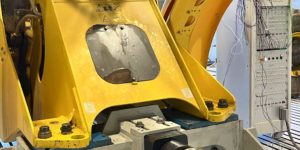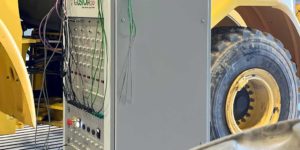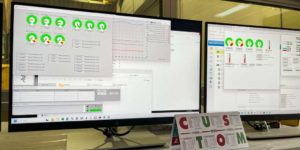One of the most recent achievements of CustoM 2.0 concerns the complete technological upgrade (Revamping of the Test Room) of a room intended for testing the engine and related cooling system of earth-moving vehicles (MMT).
The project is part of an organic and distributed project regarding a set of test rooms for PV (Product Validation).
The intervention mainly focused on replacing the automation system, upgrading the data acquisition hardware, and installing a bench motor of over 500 kW. The motor is equipped with a torsion measurement flange and a regenerative inverter.
This replaces the previous system with a single-resistance torque, based on an eddy current electrodynamic brake. Furthermore, an adaptation of the entire cell to the most recent regulations in the field of machine safety and safety and ergonomics of work environments was planned.
CustoM 2.0 has integrated an advanced automation system based on AdaMo software and cRIO hardware, as well as an Oswald motor with EEI regenerative drive for the dynamic braking system, with the possibility of adjusting in torque, revolutions, or based on specific transfer functions of the machines under test (for example, the sliding of the viscous coupling). In collaboration with Mitsubishi, a vision system based on Mitsubishi IQ-R PLC, TSN remote IO modules and a camera recorder PLC module compatible with Onvif video cameras were installed for the surveillance of the Test Room.
Test Room Revamping: New efficiency and increased energy generation capacity!
Thanks to the Test Room Revamping intervention, CustoM 2.0 has developed a state-of-the-art system for testing engines and vehicles. It combines high precision, energy efficiency, and energy regeneration capacity to ensure accurate and sustainable results.
This is another project that CustoM 2.0 is particularly proud of, as it contributes to our country’s ecological and digital transition in line with the principles of ESG.
In particular, the use of the Oswald motor with EEI regenerative drive allows for greater efficiency, reducing the energy impact of the test room, and making the plant more sustainable, thus maximizing operating costs and profits if the test in progress is carried out on behalf of third parties.
Furthermore, the advantages of using this type of motor include precise and repeatable control of the test conditions and an operating range in the torque/speed plane optimized for the application, which improves the quality of the data collected, and greater flexibility, as regenerative systems allow simulating a wider range of operating conditions, making the tests more complete and versatile.
CustoM 2.0 Services and engineering solutions since 1988 in REVAMPING SYSTEMS, ROBOTICS, TESTING SOLUTIONS




